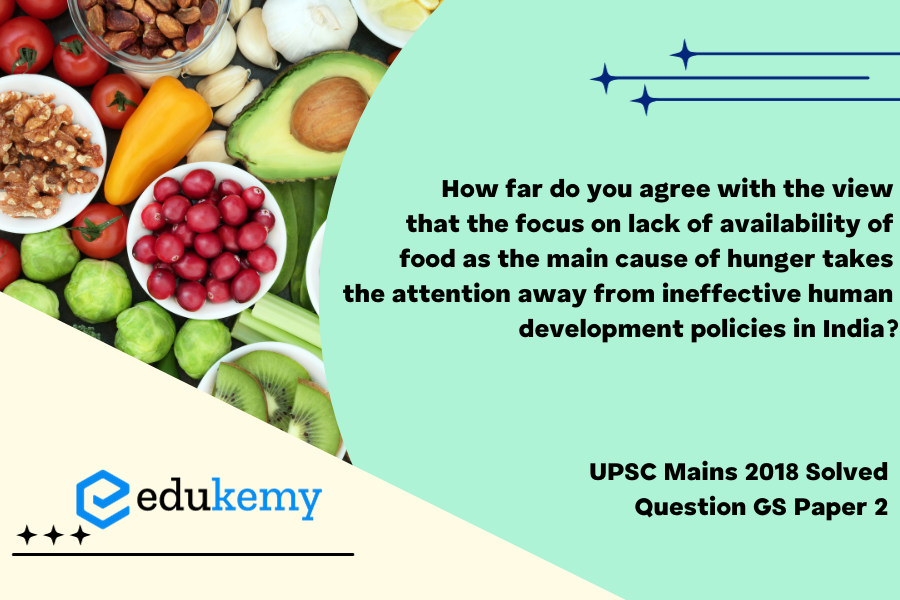The issue of hunger in India is multifaceted, with various factors contributing to its persistence. While the lack of availability of food is undeniably a significant aspect, it is essential to critically examine whether this focus on food scarcity inadvertently diverts attention from the broader context of ineffective human development policies. This essay contends that the prevailing emphasis on food availability may, to some extent, overshadow the systemic challenges embedded in India’s approach to human development. By scrutinizing the complexities beyond mere food scarcity, we can better understand the intricate interplay between socio-economic policies, educational opportunities, and healthcare access. This examination becomes crucial in order to address the root causes of hunger comprehensively. Consequently, this essay will explore the interconnection between food availability and human development policies, evaluating the extent to which the latter might be a more nuanced and overarching contributor to the persistence of hunger in India. In doing so, it seeks to provide a balanced perspective that goes beyond the surface-level analysis of food scarcity, inviting a more holistic consideration of the policy frameworks that shape the nation’s development trajectory.
Tag: Issues relating to poverty and hunger.
Contents
Decoding the Question:
- In Introduction, try to start your answer by defining huger, food insecurity.
- In Body,
- Write various Human Development Policies in India and their ineffectiveness.
- Discuss major challenges with respect to policy formulation.
- In Conclusion, try to end your answer with the effect of hunger and a way forward.
Answer:
As per FAO, Hunger is an uncomfortable or painful physical sensation caused by insufficient consumption of dietary energy. It becomes chronic when the person does not consume a sufficient number of calories (dietary energy) on a regular basis to lead a normal, active, and healthy life. India ranked 94 on the 2020 Global Hunger Index (GHI); it is lower than neighbors like Bangladesh and Pakistan. Food and Agricultural Organisation report and Hunger report 2020 triggers toward the crucial fact on Indian food insecurity, malnutrition, and poverty.
Human Development Policies in India and their Ineffectiveness:
- Mid-day meal program: In 1995 India launched Mid-day meal program where one meal is provided to all children enrolled in government schools, local body schools, government-aided schools, special training centres (STC), maktabs, and madrasas supported under the Sarva Shiksha Abhiyan. Only about 50% of the public-school children who attended school reported benefitting from the program.
- Targeted Public Distribution System: The Targeted Public Distribution System represents the largest social protection program in the world, reaching 800 million people with subsidized cereals that can be purchased from more than 5 lakh fair price shops across the country. Despite all its achievements, India tops the list of countries in the world with the largest share of the global extreme poor, with 37.2 % of the population (more than 400 million people) that is officially estimated to be living in absolute poverty, the country has the unenviable record of being home to a third of the world’s poor.
- In spite of India’s rapid economic growth, there has been a sustained decline in per capita calorie consumption during the last twenty-five years.

Major challenges:
- India has always had a low level of human development due to many major problems such as finance, education, gender inequality, and many more. These have caused many detrimental and concerning effects on India’s society.
- Important food security issues, like the stability of food consumption, dietary diversity, and food absorption & utilization, etc., are often left out of poverty programmes. Thus, the poverty alleviation programs are not enough to tackle hunger and food insecurity.
- There is a declining trend in the annual per capita consumption of cereals for all classes of people, as indicated by the NSSO data on consumer expenditure on food.
- The structural imbalances like a high Minimum Support Price (MSP), lack of land reforms, rising capital intensity, failure of poverty alleviation programmes, and no new technological breakthrough in agriculture are responsible for a high rate of hunger.
India should adopt a zero-tolerance mindset in battling hunger through long-term political commitment and effective human development policies that do not see hunger as arising only out of lack of availability of food. The country’s serious hunger level is driven by high child malnutrition and underlines need for stronger commitment to the social sector and effective human development policies rooted in ground realities of India.
In case you still have your doubts, contact us on 9811333901.
For UPSC Prelims Resources, Click here
For Daily Updates and Study Material:
Join our Telegram Channel – Edukemy for IAS
- 1. Learn through Videos – here
- 2. Be Exam Ready by Practicing Daily MCQs – here
- 3. Daily Newsletter – Get all your Current Affairs Covered – here
- 4. Mains Answer Writing Practice – here


